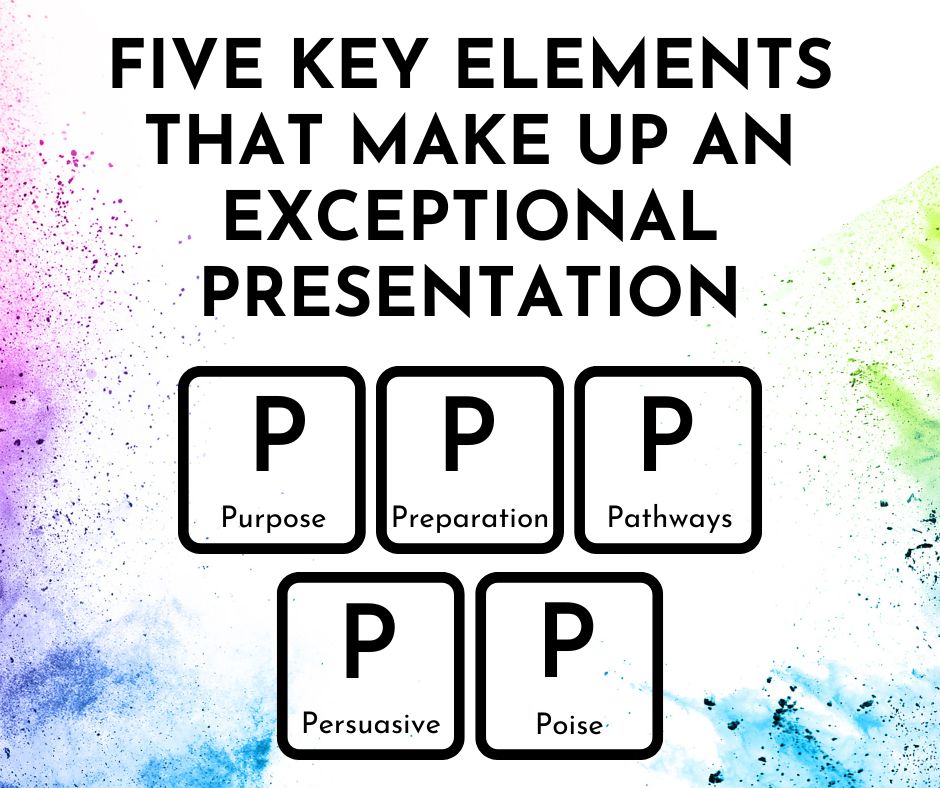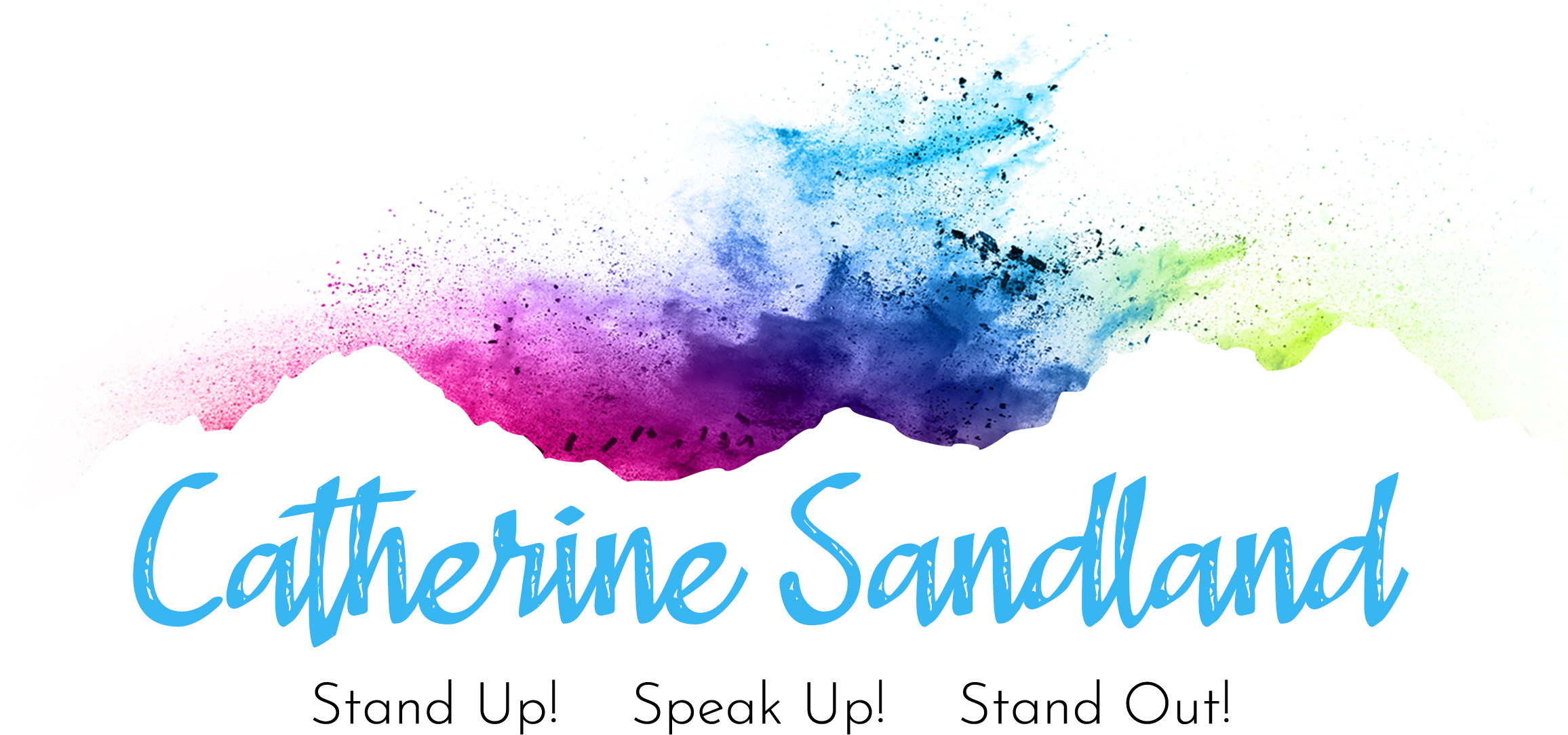The Five Essentials to Deliver Awesome Presentations
What are the elements that make excellent presentations?

Have you ever listened to a presentation, and it’s been excellent? When we listen, what are the elements that deliver awesome presentations?
Well, it would likely be a subject that was of interest to you or real value to you. It was probably delivered in a way that was interesting, engaging, and maybe even entertaining. And without a doubt, it would’ve been delivered by someone who had energy, was interesting in themselves and maybe even inspiring
Finally, it’s likely to have stayed with you. Some of the best presentations will stay with people not just for hours or days or weeks. We’re able to recall the message, the point, the story, the meaning it had for us sometimes years, even decades later.
It’s easy to look at somebody who is good at presenting and say things like
“It’s easy for them, they’re such a natural”
“Well that subject – it’s inherently interesting, isn’t it?”
“I really needed to hear that so of course it’s going to be engaging.”
Good presentations, excellent presentations, are intentional and created
Here are the five key elements that make up an exceptional presentation and will help you to deliver awesome presentations.
They don’t just happen. There are people, yes, who are brilliant speakers. There are exceptional presenters. They deliver awesome presentations. But they are not magicians. There is a craft to preparing, designing, and delivering presentations that are engaging, meaningful and influential.
These are the elements I share with my clients. And they form a blueprint to help you deliver exceptional presentations.
Handily, all these elements begin with the letter P. Presentations that make an impact and presentations that wield influence have a combination of the following five elements.
Let’s look at these in turn.

Purpose
You might have expected me to start off by talking about preparation. After all, that’s what most people do when they think about their presentation. They start to think about what it is that they want to say, start to think about their slides perhaps. They may even think about who is going to be in the audience. All of which is right of course.
I’m going to start thinking about purpose, the reason why you’re giving the presentation or talk in the first place. You see, without that clarity, there is a real danger that we download information to our audiences rather than crafting and creating something that is relevant and meaningful to them. One of the first things I often say is that to deliver awesome presentations is not to do with what you have to say, it’s about what they need to hear.
Even before we make that decision, we need to know why we are delivering the presentation. And there are two elements to this.
- First, what are you hoping to achieve by delivering this form of communication? Is it that you are selling something? Are you sharing? Teaching? Maybe you are doing a combination? The red flag warning for me is if we are informing or updating or making people aware. This is too vague and ultimately not especially helpful when crafting your talk. We need to know why we are informing, making them aware or updating. If your talk doesn’t have a purpose behind it, it is likely to meander, and even miss the point.
The second, and arguably more important, is knowing why this particular audience need to hear what you have to say? What is it that you want them to know, feel, and importantly, do as a result of listening to your presentation? What’s the outcome? What’s the takeaway?
I called this the message. The clearer the message and the greater clarity you have about the message, the more straightforward it is to prepare your presentation and, the more impact it will have when you deliver it.
Preparation
So, when we have clarity about the message, then we can get to work preparing. What does this mean? Well, here are three things to consider.
Firstly, set up a process to follow.
Secondly, make sure that you map your audience.
Thirdly, make sure that you practice and rehearse in the most effective and efficient way possible.
What do I mean by a process?
Let me share with you the process that a lot of people follow. They open up the laptop, open up PowerPoint, and download their content in the form of bullet points and occasional graphs, diagrams, and photographs. Then they talk around those slides until they are familiar with the content and comfortable and confident.
Sound familiar?
The problem with this is too much information, and overreliance on slides, slides created to help the speaker and not the audience, There is a very real potential of getting the pitch and the level completely wrong for that audience. In addition, the talk will be too long, too informational and not inspirational and quite frankly, boring.
Instead, follow the following process.
- Be clear on your WHY,(see point above)
- Decide what content the audience would need to hear in order for them to get your message (your WHAT)
- Think about how you’d like to deliver this in terms of sequencing and structuring, ( your HOW) and finally, if at all,
- Decide what visual aids you might want to use to support, enhance, and clarifies your talk.
Notice, that visuals come towards the end of the process, rather than at the beginning. Indeed, you might have either no visual aids or very few. And the ones that you do use will be brilliant because they serve a specific purpose and have been designed for the audience.
Let’s talk about mapping your audience.
This is more than knowing how many people will be there and their job titles.
This is really digging deep into your audience’s lived experience. Seek to understand the world they live in. With its dreams, aspirations, problems, and issues. Think wider than the solution or point of view that you were about to offer. Their world is not centred on your message. At this point. The more that you know what your audience sees, hears, and feels, the easier and the more powerfully you can connect with them. It means you will use the language, the words, the phrases and the stories that they use. It means you can connect most deeply with them and because of that, you will have more impact and more influence.
And finally, we need to discuss the rehearsal.
We need to discuss it because most people do it wrong if they do it at all. There is a traditional view that rehearsal comes at the end of the process when we’ve worked it all out, and it’s just about remembering what comes where and making sure we don’t forget our words.
And of course, there is some truth to that.
However, my view is that rehearsal is made up of a number of stages. And it starts much earlier than most people believe possible. It starts before you even fully know exactly what you’re going to say.
Let me explain.
When we write things down, we often use written English. What that means in practice is long sentences, words we wouldn’t use if we were talking to someone sitting next to us in a coffee shop. It can be stilted language. And it might not always make sense when you say it out loud.
So say it out loud.
When you’re thinking of what to say try it out loud before you even write it down. Or if you need to write it down, say it out loud to test the sense of it. And replace and amend and adjust until it sounds good. We call this the Sounding Out stage.
There’s another stage that I encourage people to take as well. I call it the Stumble Through. It’s possibly the most painful part of the whole process! When you’ve got a vague idea of where you might be starting from, where you’re going to end up and some of the key milestones in your talk, then just run through it.
It’ll be horrible. There will be lots of jerkiness, and clumsiness. You’ll realise quickly whether it flows, makes sense, it’s too complicated, or needs clarifying.
And that’s the point really. You won’t get that fully by looking at words or bullet points on a written page. Or even a slide. You only know that when you say it out loud. The Stumble Phase, in my opinion, is the most valuable part of any preparation process.
Practising is then the next stage of rehearsal. It’s practising, not remembering things word for word. It’s practising so that you can keep changing and adjusting and enhancing the way that you deliver it. This is about testing for delivery. It’s about deliver awesome presentations.
- Where do you want to pause?
- Where can you put the emphasis?
- What can you do with your body language and the space around you that will enhance your message?
This is the exact opposite of ‘running through a presentation. It’s practising the delivery as you will wish to deliver it in your talk.
So give yourself time and space to do this. And, if you have a trusted person, let them help you practice as well. Feedback, during the practice sessions, can be invaluable, if it’s from the right person and it’s constructive.
A dress rehearsal or stage rehearsal is the last part of your rehearsal process. And that’s where you’re making sure that the technology works, you’re wearing the right stuff, you know if you’ve got space you need to move around. The bigger and more important the audience, the venue, and the outcome of your talk, the more important it is to have a proper dress rehearsal.
Pathways
So far we have discussed the purpose and some elements of preparation. But now let’s think about pathways
What I mean by pathways is working out the sequence and the structure of your presentation.
The first part of this is to work out the journey you’d like your audience to take with you. (Notice, I am not saying here that you need a list of bullet points to talk through!). When people are listening to you, they need to have a roadmap to follow. They need to be able to make sense and follow what you’re saying. Even when you know what the structure is, you need to make that clear to the audience as well. I call it navigating the audience from the beginning all the way through your key points to your final thought.
The second part of this is to think about how you can deliver in a way that makes sense and is sticky ( people can recall it afterwards). This is also about creating and putting a shape on your content. It’s not just listing information or putting your information in bullet points but crafting your content.
- Could you tell a story?
- Could you model your content?
- Can you break it down into digestible chunks,
- How can you make this memorable?
- What could you say to make it stick?
- How can you shape it so that people understand it while you’re delivering it, connect with it, and they can recall it afterwards?
Listing bullet points is so much easier, but so less engaging and certainly has no impact at all. It’s a sure-fire way of sending your audience to sleep.
Persuasive Language
I am a great believer that presentations give us an opportunity to have an impact on our listeners and increase our influence and make a difference when we speak.
It’s no surprise that a key element of an excellent presentation is the use of persuasive language. Yes, these are the words, the phrases, the sentences, and the stories that we use. It’s the references that resonate, the terms that our audience use and is familiar with. Thinking carefully and intentionally about how you might put across your point. It’s about understanding what motivates our listeners and then delivering to match that motivation. Creating a hunger for what we have to say. Appealing to the way people process, think and are influenced. From a place of good intent.
Too often people use the first words that come into their head. Imagine if instead, they thought about the BEST words, The BEST stories. The BEST phrases.
Poise
And finally, of course, you can deliver awesome presentations with poise. POISE is my anacronym. To deliver with poise, we need to have
P – posture,
O – outward-looking,
I – involve our audiences
S – smile,
E – eye contact.
Let’s take that in turn:
Posture is taking time to tune into our bodies and make sure that we look credible and confident and in control. When we do this, we also ensure that we can breathe effectively, we make sure that we are ‘present’ ie not inside our heads but aware of what we can see, hear and feel.
Outward looking means being consciously aware of what is around us. In my training, I call this peripheral vision. Creating a state in which you are aware of what is on the edge of your vision. When we do this we can start to be in tune with the audience which enables us to react and respond to them in a way that can be incredibly powerful.
Involving our audiences is an interesting one. Whoever said that attending a presentation should be a passive affair. Yet, time and time again, people go and are allowed to sit back and observe a presentation rather than be required to be actively involved. Make sure that you demand participation whether that is to ask your audience to picture something, think of something, laugh, cry, be amazed or be concerned. You can even ask them to physically participate by putting their hands up, looking around them or even standing up.
Smiling at the audience is not the same as simpering! Each smile has a purpose. In the beginning, it is to reassure and welcome and signal that you are ready to speak and feel confident that you can do so. Smiling during a presentation can signal that it is ok, and can encourage the audience to relax. Smiling at the end can be a way of asking questions, signalling the end or reaffirming a point.
Eye contact is your main way as a speaker of connecting with your audience at a deep human level. It is affirming and personal and powerful. Eye contact can also give you a degree of control over your audience. Directing a comment at a part of the audience is achieved through eye contact. Emphasising a point can be done through eye contact. Demanding attention can be done through eye contact.
At the beginning of this blog, I stated that
Good presentations, excellent presentations, are intentional and created.
You too can deliver awesome presentations!
There is a craft to preparing, designing, and delivering presentations that are engaging, meaningful and influential. You can deliver awesome presentations.
The opportunity to stand up and speak is a precious one. It leverages your time and your impact. Don’t waste it by delivering boring, mediocre talks. Be intentional and create something that makes a difference.
